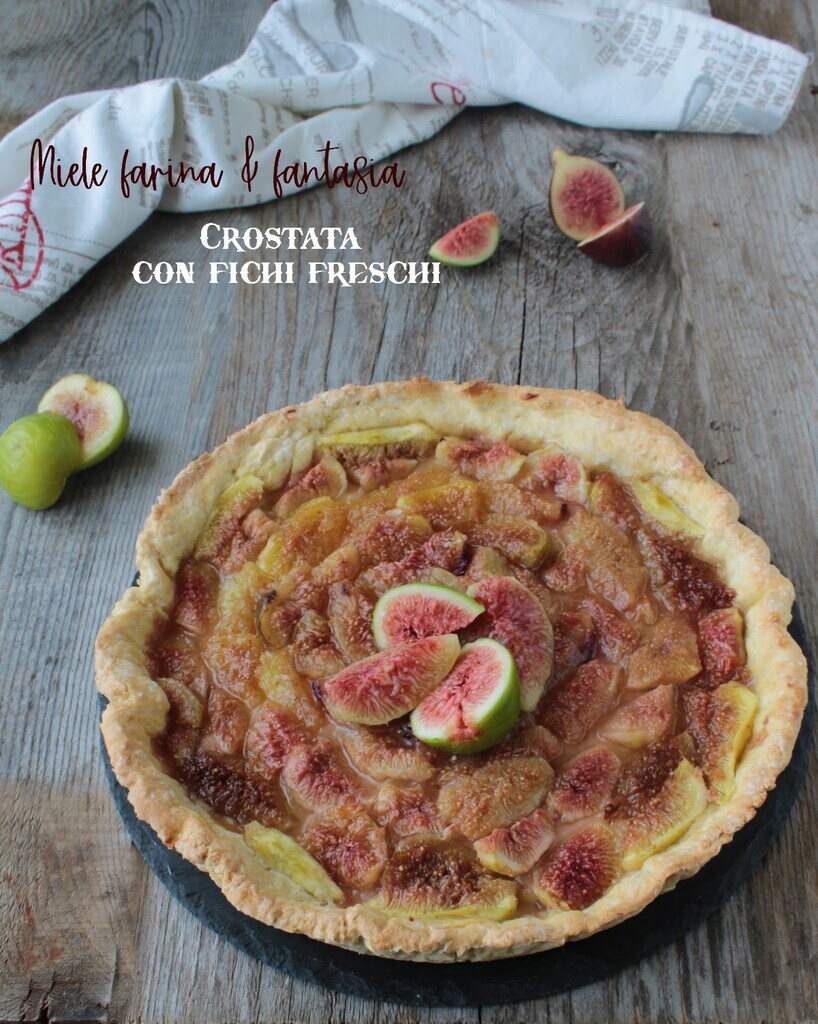Today I present a dessert that is attractive, elegant, refined, and aromatic, the tart with fresh figs. It’s a very simple dessert to make, crafted with a delicious shortcrust pastry base and a filling of fresh figs that will caramelize during baking. This rich and indulgent tart can be prepared with either wheat flour or gluten and lactose-free flours, and in the process, you’ll find both recipes.
Happy reading

- Difficulty: Very Easy
- Cost: Medium
- Rest time: 12 Hours
- Preparation time: 30 Minutes
- Portions: 10
- Cooking methods: Oven
- Cuisine: Italian
- Seasonality: Fall, Summer, Fall
Ingredients
- 21 oz fresh figs
- 1 tbsp brown sugar (or granulated)
- to taste grated lemon peel
- 1 tsp Strega liqueur (optional)
- 2 cups all-purpose flour (or 0)
- 3 egg yolks (cold from the fridge)
- granulated sugar
- tsp fine salt
- cold butter cut into pieces
- to taste chopped lemon peel
- 1 tsp liqueur of choice
- 2 cups gluten-free flour mix for bread and pizza*
- 2 medium whole eggs
- granulated sugar
- tsp fine salt
- cold butter cut into pieces (also lactose-free)
- to taste grated lemon peel
- 1 tsp liqueur of choice
Tools
- 1 Baking Pan
Steps
To make our tart with fresh figs, we’ll need a round flared mold with a maximum diameter of 8-9 inches.
Let’s start with the wheat shortcrust pastry.
In a very large bowl, we sift the all-purpose or 0 flour very well (the 0 flour might require an extra yolk to achieve the right consistency, as it absorbs more liquids).
Add the sugar, salt, and the finely grated peel of a whole lemon.
Mix the powders (that is, the dry ingredients) with your hands, and add all the yolks.
Mix well and finally add the cold butter from the fridge, cut into pieces.
Knead quickly (with your hands or a mixer) to avoid overheating the dough. It doesn’t matter if the butter is not perfectly absorbed by the dough. If you notice the dough is too hard, you can add another yolk.
Place the dough between two sheets of parchment paper and flatten it with a rolling pin until you form a sort of finger-thick circle. Immediately transfer it to the fridge, to the coldest part. Let it rest from a minimum of 2 hours to a minimum of 12 hours. The more the shortcrust pastry rests in the cold, the better.
After the resting time of the shortcrust pastry, let’s deal with the fresh figs, which must be ripe but not overly so, as they might release too much vegetation liquid during cooking, which could ruin the base; if your figs are very ripe, I will indicate a sort of trick (you might already know it) to prevent the bases of shortcrust pastry, brisée, or puff pastry from becoming too moist and ruining.
Wash the figs under running water and dry them. You can decide whether to leave the peel or not; in the second case, remove it completely.
Cut the fruits into 2 or 4 wedges, depending on their size.
Preheat the oven to 356°F.
Take the dough out of the fridge. With a rolling pin, continue rolling it out until it’s about 0.4 inches thick.
With the help of parchment paper, place the dough in the mold, remove the sheet from the surface, and even out the shortcrust pastry inside the mold
Fill the tart with the already sliced figs, filling every space.
Finish with a sprinkle of brown sugar (or granulated) and a little very, very finely grated lemon peel.
As I wrote above, if your figs are too ripe or you don’t want to risk it, before adding them, brush the inside of the shortcrust pastry very well with an egg white, which will make it perfectly waterproof.
Bake the tart in the middle of the oven for about 40 minutes or until it becomes uniformly golden both beneath and around the edges.
Remove it from the oven and wait until it is completely cool to remove it from the mold, to avoid breaking it.
For the gluten-free shortcrust pastry, just follow the procedure described above, also for resting the dough, baking, and so on.
Since gluten-free flours absorb a greater amount of liquids, I preferred to use 2 whole eggs instead of adding more yolks.
This time, I chose to use a mix of gluten-free flours and starch (without added salt, sugar, and yeast).
If you don’t want to use ready-made mixes, here you’ll find the recipe for another sweet tart made with rice flour and cornstarch.

